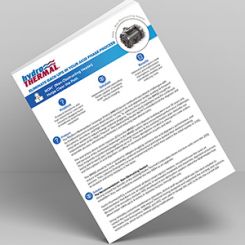
The Hydraulic Institute (HI) recently published a white paper, Specifications of Test Acceptance Grades (2022), which is free to download and intended to educate the reader regarding the technical considerations involved in the selection of a test acceptance grade. The white paper intends to help the reader determine an appropriate pump performance acceptance grade as specified in ANSI/HI 14.6 Rotodynamic Pumps for Hydraulic Performance Acceptance Tests and ISO 9906 Rotodynamic pumps—Hydraulic performance acceptance tests —Grades 1, 2, 3 to ensure the tested pump operates as intended.
The selection of a pump performance acceptance grade can have a significant impact on both the short- and long-term functionality of a pump. An informed decision is important and can be made through technical consideration of system criteria and characteristics, and an evaluation of pump performance. If, however, an inappropriate acceptance grade is selected, there can be negative consequences. In the short term, specification of a more restrictive acceptance grade (Grade 1, for example) can add costs and delivery time to the procurement of the pump. An improper acceptance grade can cause the system to operate differently than expected. This may increase energy consumption, fail to meet the system requirements and exceed system and pump capabilities.





The suitable grade is often dependent on the method used to control the pump, a thorough knowledge of the system’s required operation and the pumping requirements of the application. It is not just a matter of controlling the pump output; the system response must also be considered. The topics illustrated in Images 1–4 should be considered.
In addition to the consideration of the suitable acceptance grade, there is the decision concerning whether the tolerance should be applied unilaterally or bilaterally. This decision can have a major impact on both the operating and equipment costs. The head and flow tolerances for Grades 1, 2 and 3 are a consistent percentage, whether the tolerance is bilateral or unilateral. The example graph (Image 5) shows the guaranteed point in center of bilateral tolerance grade boxes. The manufacturer will design the pump performance to meet or be close to this point. In a unilateral tolerance grade, the guaranteed point is in the lower left corner of the box.
The manufacturer designs the pump to be, again, in the center of the acceptance grade box. This compels the manufacturer to design/select a pump that will be at a higher flow and head than is required for the duty point. This all but guarantees the pump will require more energy than required at the duty point. Only in the red shaded area will both Grade 1U and 1B lead to the same energy consumption. However, relative to energy consumption, this area is the worst-case scenario for Grade 1B and the best-case scenario for Grade 1U.
The additional 1U tolerance may also require a larger motor and thus increase the equipment costs. For more information on the economic and logistical issues that should be considered when selecting an acceptance grade, please see the HI white paper Understanding the Effects of Selecting a Pump Performance Test Acceptance Grade (2018).
References
Hydraulic Institute, Specifications of Test Acceptance Grades (2022)
Hydraulic Institute, Understanding the Effects of Selecting a Pump Performance Test Acceptance Grade (2018)
Hydraulic Institute, ANSI/HI 14.6 Rotodynamic Pumps for Hydraulic Performance Acceptance Tests (2022)
ISO 9906 Rotodynamic Pumps – Hydraulic Performance Acceptance Test – Grades 1, 2 and 3. (2012)

